DISCUSSION OF AMANITA MUSCARIA VAR. GUESSOWII
Amanita muscaria, a common species in much of the world, occurs in a diversity of forms and colours. Many of these variations have been described as distinct varieties and have a more restricted geographic range than the species as a whole. In New Brunswick you are most likely to encounter A. muscaria var. guessowii. The varietal name guessowii was given in honour of Dr. Hans T. Güssow (1879-1961), Dominion Botanist of the Dominion Experimental Farms, Canada for 33 years. Although the variety was described in 1933 it never gained much recognition and was considered by most to be a later synonym of A. muscaria var. formosa (Pers.) Bertill. However, the distinguished student of Amanita Dr. Rodham Tuloss has pointed out on his web site that A. muscaria var. formosa has been incorrectly applied to North American collections, and that these should be called A. muscaria var. guessowii.
Amanita muscaria var. guessowii can be found in New Brunswick throughout the summer and fall. We have seen it in New Brunswick in June, August, September and October. Although we have no July collections it probably appears in that month as well. The collection shown in the photo on the previous page was fruiting on a lawn near Lepreau, New Brunswick. This particular fungus first appeared two years after the land had been cleared, a house built and a lawn planted. It may have been established here previous to these disturbances, but it has clearly survived under present conditions and has fruited at least three times since its first appearance. It is not known whether this fecundity represents the last efforts of a dying mycelium or the output of a thriving pioneer.
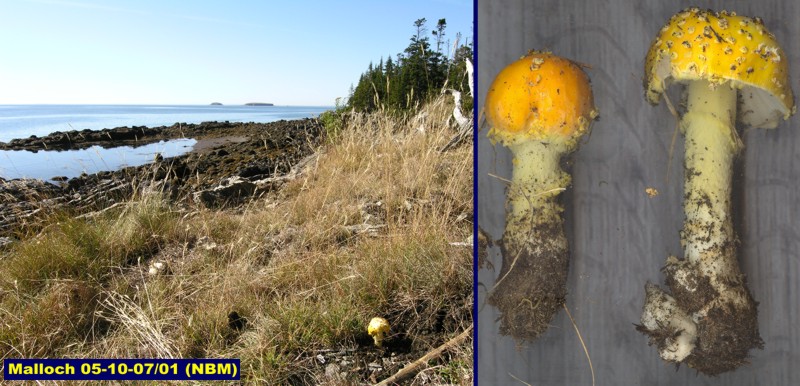 The fruiting of A. muscaria var. guessowii on a lawn with trees is not uncommon but it can also be found in other disturbed habitats. The fruiting body in the picture at right was found growing on a peaty seaside enbankment where it could be exposed to strong drying winds, hot sun, driving rain and spray from ocean waves. Although this habitat showed little human influence it was clearly not a stable environment. Most of our New Brunswick collections have been gathered in such habitats; in fact, this variety is not commonly encountered here in deep undisturbed woods. However, it has been collected several times in Ontario and Quebec in relatively undisturbed forest, so it is unwise to draw any final conclusions until its ecology is more thoroughly studied.
The fruiting of A. muscaria var. guessowii on a lawn with trees is not uncommon but it can also be found in other disturbed habitats. The fruiting body in the picture at right was found growing on a peaty seaside enbankment where it could be exposed to strong drying winds, hot sun, driving rain and spray from ocean waves. Although this habitat showed little human influence it was clearly not a stable environment. Most of our New Brunswick collections have been gathered in such habitats; in fact, this variety is not commonly encountered here in deep undisturbed woods. However, it has been collected several times in Ontario and Quebec in relatively undisturbed forest, so it is unwise to draw any final conclusions until its ecology is more thoroughly studied.
Species of Amanita all form mycorrhizae, an essential mutualsm (beneficial symbiosis) between a fungus and the roots of a plant. Although some mycorrhizal fungi are able to associate with the roots of one kind of tree A. muscaria var. guessowii appears to be able to join forces with several different partners. In our area it usually associated with conifer roots, balsam fir in the two examples given above, but it may also be found around hardwood trees. Its lack of specificity to a particular tree combined with its preference for disturbed habitats leads to it being found commonly around human habitations.
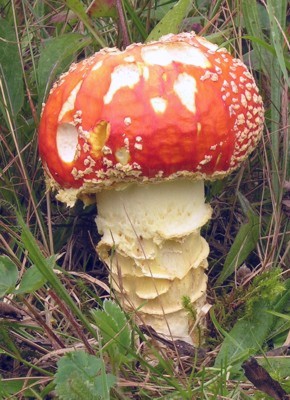
Because its fruiting bodies are large and brightly coloured A. muscaria var. guessowii is sometimes gathered and eaten by people expecting to have a tasty meal. Unfortunately it is toxic and causes severe vomiting and diarrhea within a half hour of being consumed. In more than 30 years as a consultant to the Poison Information centre in Toronto I have encountered numerous poisoning by this mushroom, as many as 10 in a week. These poisonings are not fatal, but they do provide a very unpleasant end to a good meal. Some forms of this species are said to be hallucinogenic but A. muscaria var. guessowii seems only to affect the gastrointestinal tract.
Collections of A. muscaria var. guessowii from our region have yellow veil remnants on the stipe as well as a partially yellow annulus. These yellow colours may be entirely lacking in collections from other regions but seem to be consistently present in New Brunswick. The picture at left shows a young fruiting body of A. muscaria var. guessowii growing in a grassy field near Gros Morne National Park in Newfoundland. Note that the stipe is almost completely white, and then compare it with the coastal New Brunswick example above with its yellowish stipe and annulus. In fact the Newfoundland example seems larger and more robust than either of the New Brunswick collections and, combined with the redder pileus, more like A. muscaria var. muscaria as it is known on the west coast of North America and most of Europe. However, the Newfoundland collections from Gros Morne became orange later in their development and appeared to fit the concept of A. muscaria var. guessowii.
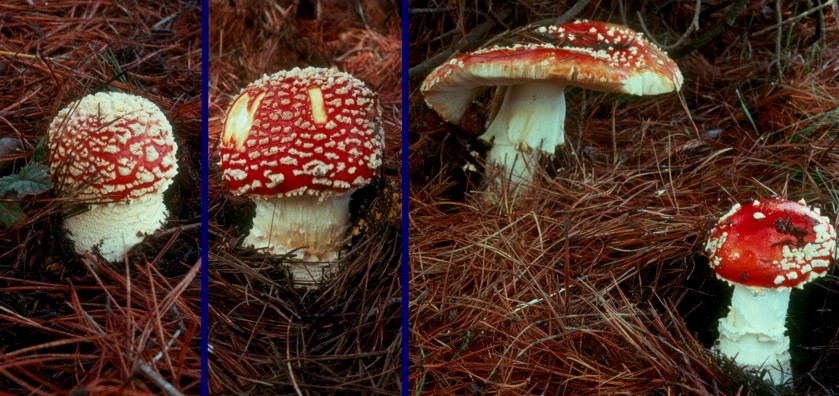
Amanita muscaria var. muscaria, seen at right growing under Monterey pine in coastal California, is strikingly similar to the specimen from Newfoundland. However, the mature fruiting body retains the deep red colour of the buttons and shows none of the orange colour of A. muscaria var. guessowii. Also note the robust stature of these mushrooms compared to the coastal New Brunswick material. Although common elsewhere, A. muscaria var. muscaria may not occur in our region at all. Our checklist reports A. muscaria without a varietal name because most authors have not specified the variety of their collections. However, it is likely that all of these represent the variety guessowii.
Another feature of A. muscaria var. guessowii that has attracted attention is the occasional appearance of a volva or cup around the bulb of the stipe. While a well-developed sack-like volva is characteristic of many Amanita species it is generally said to be represented in varieties of A. muscaria by scales or rings of veil material on the stipe above the bulb. The presence of a volva was the cause of some controversy in one instance when the aformentioned Dr. Güssow and Mr. W.S. Odell published their book Mushrooms and Toadstools (Canada Dept. Agric., Ottawa, 1927) containing a coloured painting by Dr. Güssow of this mushroom with a conspicuous volva. The book also had a photograph of the collection painted by Dr. Güssow, which also clearly showed a volva. Although one might have suspected Dr. Güssow of exaggerating this feature the photograph clearly shows the accuracy of his painting.
The presence of a volva where it is not usually expected may have attracted attention but it also sparked a small controversy. In 1948, the respected American wildlife artist Walter A. Weber did a painting of A. muscaria var. guessowii for the National Wildlife Federation's annual wildlife stamps. To ensure the accuracy of his painting he consulted Güssow and Odell's book and "corrected" his painting to include the prominant volva shown in their plates. After the stamp was produced he received a rather terse note from the eminent American mycologist Dr. W. A. Murrill informing him that the species should not have a "deathcup" and that "every figure on the stamp is fitted with one gratuitously". Mr. Weber wrote to Dr. Güssow asking about this. Since Dr. Güssow had retired by this time and moved from Ottawa to the west coast, Dr. J. Walton Groves, himself a noted authority on Canadian mushrooms, answered the letter sayng that Mr. Odell and others had objected to Dr. Güssow including these illustrations in the book, "but since Dr. Güssow was chief of the Division the other people here at that time were powerless to do anything about it".
Although subject to controversy there is little doubt that some collections of A. muscaria var. guessowii have what appears to be a cup-like volva. The volva is usually said to be represented by rings of material around the lower part of the stipe, and this is usually the case. However, if one of the "rings" fails to separate from the stipe base it will remain as a cup.
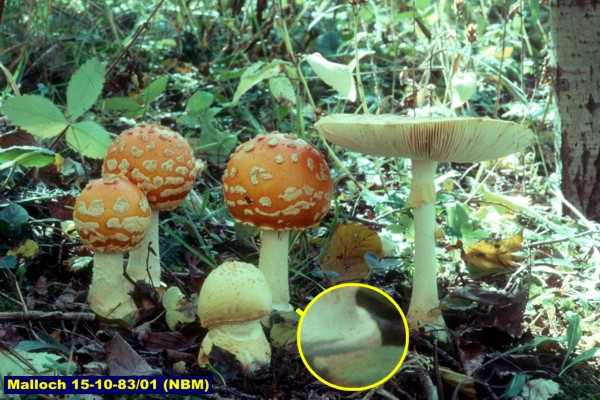
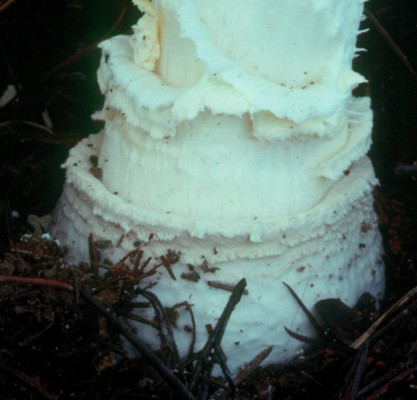 The two pictures at left illustrate just such a situation. The leftmost picture is of a rather typical group of A. muscaria var. guessowii growing under aspens in Mississauga, Ontario. The inset shows the base of one of the stipes with a cup-like volva. The rightmost panel is taken from the California collection of A. muscaria var. muscaria illustrated above. Here the volva has clearly developed as a cup, although it is present as separate rings of material as well. Variations in geography, climate, local conditions, and season, as well as genetics, all play a part in producing the diversity of forms seen in even a variety of a well-known species like Amanita muscaria.
The two pictures at left illustrate just such a situation. The leftmost picture is of a rather typical group of A. muscaria var. guessowii growing under aspens in Mississauga, Ontario. The inset shows the base of one of the stipes with a cup-like volva. The rightmost panel is taken from the California collection of A. muscaria var. muscaria illustrated above. Here the volva has clearly developed as a cup, although it is present as separate rings of material as well. Variations in geography, climate, local conditions, and season, as well as genetics, all play a part in producing the diversity of forms seen in even a variety of a well-known species like Amanita muscaria.
David Malloch
New Brunswick Museum